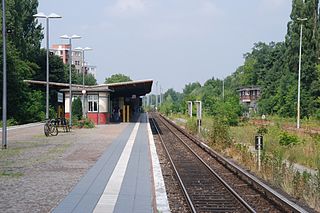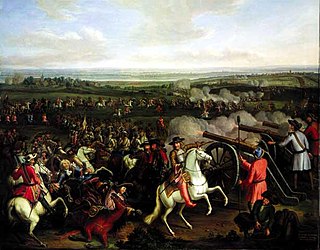
The Kremmener Luch is a shallow fen, known locally as a luch , between the Glien plateau (near Berlin) in the south, and the Beetzer Heath in the north.

The Kremmener Luch is a shallow fen, known locally as a luch , between the Glien plateau (near Berlin) in the south, and the Beetzer Heath in the north.
The western Rhin flows through the Kremmener Luch, where it is called the Kremmener Rhin, or the Ruppiner Canal.
The Kremmen Lake, which is embedded in the Kremmener Luch, was converted into a nature preserve in 1924. This wildlife preserve is 11 square kilometres large today, and there can one can still see cranes, beavers, and European otters. For 300 years the Kremmener Luch has been drying up, and today, the greater part of it is suitable for agricultural usage, and has thus lost its moorish character.
The Kremmer Dam, scene of the decisive battle which established the Hohenzollerns as rulers of Brandenburg, goes through the Luch, the only road connection to the north, though the Kremmen-Neurippin railway line also provides access to the north.

The Palatinate, or the Rhenish Palatinate (Rheinpfalz), is a historical region of Germany. Prior to World War 2, it was known as Rhenish Bavaria; as a state of the Holy Roman Empire, it was known as the Lower Palatinate (Unterpfalz), which designated only the western part of the Electorate of the Palatinate, as opposed to the Upper Palatinate (Oberpfalz). It occupies roughly the southernmost quarter of the German federal state of Rhineland-Palatinate (Rheinland-Pfalz), covering an area of 2,105 square miles (5,450 km2) with about 1.4 million inhabitants. Its residents are known as Palatines (Pfälzer).

Bas-Rhin is a department in Alsace which is a part of the Grand Est super-region of France. The name means 'Lower Rhine', referring to its lower altitude among the two French Rhine departments: it is downstream of the Haut-Rhin department. Note that both belong to the European Upper Rhine region. It is, with the Haut-Rhin, one of the two departments of the traditional Alsace region which until 1871, also included the area now known as the Territoire de Belfort. The more populous and densely populated of the pair, it had 1,148,073 inhabitants in 2020. The prefecture is based in Strasbourg. The INSEE and Post Code is 67.

Haut-Rhin is a département in the Grand Est region, France, bordering both Germany and Switzerland. It is named after the river Rhine. Its name means Upper Rhine. Haut-Rhin is the smaller and less populated of the two departments of the former administrative Alsace region, the other being the Bas-Rhin. Especially after the 1871 cession of the southern territory known since 1922 as Territoire de Belfort, although it is still densely populated compared to the rest of metropolitan France. It had a population of 767,842 in 2020.

The Rhins of Galloway, otherwise known as the Rhins of Wigtownshire, is a hammer-head peninsula in Dumfries and Galloway, Scotland. Stretching more than 25 miles from north to south, its southern tip is the Mull of Galloway, the southernmost point of Scotland.

Durlinsdorf is a commune in the Haut-Rhin department in Alsace in north-eastern France.

Berlin-Wittenau (in German S-Bahnhof Berlin-Wittenau, officially Wittenau (Wilhelmsruher Damm)) is a railway station in the Wittenau district of Berlin, Germany. It is served by the Berlin S-Bahn and numerous local buses. It is also the northern terminus of the Berlin U-Bahn line .

Berlin Karl-Bonhoeffer-Nervenklinik is a railway station in the Reinickendorf borough of Berlin, Germany. It is served by the Berlin S-Bahn, the line of the Berlin U-Bahn and named after the adjacent homonymous psychiatric hospital in Wittenau. The namesake psychiatrist Karl Bonhoeffer (1868–1948) was the father of the resistance fighters Klaus and Dietrich Bonhoeffer. Whereas the hospital and the underground station are located in the locality of Wittenau, the S-Bahn station happens to be in the adjacent Reinickendorf, both localities of the Reinickendorf borough.

Berlin-Schönholz railway station is a railway station in Berlin, Germany. It is located on the Berlin Northern Railway line in the district of Reinickendorf, though it is named after the adjacent Schönholz quarter of the neighbouring Pankow district. From here, the Kremmen Railway branch line leads to Hennigsdorf and Kremmen. The station is served by S-Bahn trains and local bus lines, and is protected as a listed monument.

Hilsenheim is a commune in the Bas-Rhin department in Alsace in north-eastern France.

Rhinau is a commune in the Bas-Rhin department of Grand Est in north-eastern France.

Ruppiner See is a lake in Ostprignitz-Ruppin, Brandenburg, Germany. At an elevation of 36.5 m (120 ft), its surface area is 8.25 km2 (3.19 sq mi). It is believed to have formed as a glacial tunnel valley.

Hennigsdorf is a railway station in the Oberhavel district of Brandenburg, located in the town of Hennigsdorf. It is the northern terminus of the S-Bahn line as well as a station for regional passenger trains and freight services.

The Kremmen Railway is a line in northern Berlin and Brandenburg, Germany. It branches off the Prussian Northern Railway in the Berlin district of Reinickendorf, north of Schönholz station and then passes through Tegel, Hennigsdorf and Velten to Kremmen. There it connects with the Kremmen–Meyenburg line opened in 1898 to Neuruppin.

The borders of the oceans are the limits of Earth's oceanic waters. The definition and number of oceans can vary depending on the adopted criteria. The principal divisions of the five oceans are the Pacific Ocean, Atlantic Ocean, Indian Ocean, Southern (Antarctic) Ocean, and Arctic Ocean. Smaller regions of the oceans are called seas, gulfs, bays, straits, and other terms. Geologically, an ocean is an area of oceanic crust covered by water.

The Swedish invasion of Brandenburg (1674–75) involved the occupation of the undefended Margraviate of Brandenburg by a Swedish army launched from Swedish Pomerania during the period 26 December 1674 to the end of June 1675. The Swedish invasion sparked the Swedish-Brandenburg War that, following further declarations of war by European powers allied with Brandenburg, expanded into a North European conflict that did not end until 1679.

The Rhinluch is a fen landscape in the German state of Brandenburg, bisected by the river Rhin to which it owes its name. This wetland region lies north of Fehrbellin in the county of Ostprignitz-Ruppin. The upper Rhinluch covers an area of about 23,000 hectares. The suffix luch is used to describe several wet areas in the state of Brandenburg, in which, prior to the advent of modern drainage systems, water remained largely stagnant rather than flowing.

The Havelland Luch is a lowland area inside a bend of the River Havel west of Berlin, and forms the heart of the Havelland region.

A Ländchen is the German name given to several Ice Age plateaux in the Havelland region, which climb to over 70 metres above the formerly marshy urstromtal levels of the Havelland Luch and the Rhinluch. The difference between these Ländchen and the surrounding countryside is even more marked because of the different land uses to which they are put. Extensive pastures in the lowlands contrast with the arable fields and woods on the low hills. Geologically they are largely complete formations of ground moraine from the Saale and Weichselian glaciations that, in places, are covered by gently rolling end moraines.

Geographically, the Havelland is the region around which the River Havel flows in a U-shape between Oranienburg to the northeast and Rhinow to the northwest. The northern boundary of the Havelland is formed by the River Rhin and the Rhin Canal. In the history of Brandenburg, the Havelland represents a historic region.
Hanging Bog State Preserve is a 16-acre (6.5 ha) forest that is on the edge of the Cedar River valley in Iowa. It was deeded to The Nature Conservancy in 1968, and it became a state preserve in 1981.